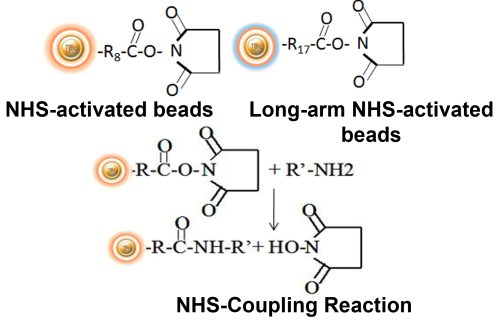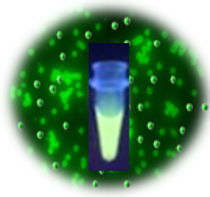

BcMag™ NHS-activated Terbium Fluorescence Magnetic Beads are Time-Resolved Fluorescence (TRF) magnetic microspheres coated with high-density NHS (N-hydroxyl succinimide) functional groups on the surface. The magnetic resin utilizes reliable NHS-ester chemistry and does not require the use of dangerous chemicals for immobilization. The beads have less nonspecific binding and no leaking of the coupled ligand. The resin can quickly, efficiently, and covalently conjugate any primary amine-containing ligands by forming stable amide linkages with better than 85% coupling efficiency. The NHS-Activated beads reactions take less than an hour (15–30 min at room temp pH 7–9, 4 hours at 4 °C) and produce substantially more stable linkages.

 The amine group (-NH2) is the most common functional target for immobilizing protein molecules: This group can be found at the N-terminus of each polypeptide chain (called the alpha-amine) and in the side chain of lysine (Lys, K) residues (called the epsilon-amine). Because of their positive charge under physiological conditions, primary amines are frequently outward-facing (i.e., on the outside surface) of proteins; hence, they are usually available for conjugation without denaturing the protein structure.
The amine group (-NH2) is the most common functional target for immobilizing protein molecules: This group can be found at the N-terminus of each polypeptide chain (called the alpha-amine) and in the side chain of lysine (Lys, K) residues (called the epsilon-amine). Because of their positive charge under physiological conditions, primary amines are frequently outward-facing (i.e., on the outside surface) of proteins; hence, they are usually available for conjugation without denaturing the protein structure.The microspheres combine the benefits of the active NHS group, time-resolved Fluorescence dyes, and magnetic characteristics to perform very sensitive assays. The beads are manufactured using nanometer-scale superparamagnetic iron oxide and Terbium metal as core and entirely encapsulated by a high-purity silica shell, ensuring no leaching problems with the iron oxide and Terbium metal. The hydrophilic surface provides beads with low nonspecific adsorption, excellent dispersion, and easy handling in various buffers.
Although conventional fluorophores have been widely used over the past decades, they still suffer from either one or several limitations in terms of applicability and efficiency:
1.
Narrow excitation bands cause higher background signals.
2.
Smaller Stokes shift often produces self-quenching.
3.
Fluorescence is sensitive to environmental factors such as metallic ion concentration, pH, temperature, and solvent polarity.
4.
Fluorescence intensity is not high enough for detecting a single biomolecular.
5.
Fluorescence intermittency (blinking) affects some processes of molecule detection.
6.
Easily aggregated because of hydrophobicity.
BcMag™ TR-FRET (Time-Resolved FRET) Assay
BcMag™ TR-FRET Assay, in contrast to typical FRET (Förster Resonance Energy Transfer) assays, uses time-resolved Fluorescence magnetic beads (BcMag™ TR-Magnetic Beads) as the donor fluorophore. The donor and acceptor can be two proteins, two DNA strands, an antigen, an antibody, or a ligand and its receptor. After a reasonable time delay (usually 50 to 100 s), a signal is generated by fluorescence resonance energy transfer between a donor and an acceptor molecule when they are close and monitored in a time-resolved way. In BcMag™ TR-FRET Assay, a trace amount of analytes can be easily enriched from the complex by TR-Magnetic Beads, resulting in higher sensitivity. This assay practically eliminates all fluorescence backgrounds caused by the sample and plastic microplate, as well as by direct acceptor excitation. As a result, the signal-to-noise ratios of the BcMag™ TR-FRET Assay are very high, and the background is quite low. Furthermore, the assay does not need washing steps. BcMag™ TR-FRET Assay offers substantial advantages to bioassays in high throughput screening, such as assay flexibility, dependability, increased assay sensitivity, higher throughput, and fewer false positive/false negative results.
Terbium cryptate fluorophore is an efficient Fluorescence label due to its distinct specific properties. It is excited at 320nm and emits green fluorescence at 545nm, with a long fluorescence lifetime (1050 μsec) and large stokes shifts (220 nm). By taking advantage of these properties, time-resolved fluorescence measurement can dramatically reduce the fluorescence background from the sample and increase the signal-to-noise ratio to offer detectability better than one order of magnitude than conventional Fluorescence dyes. BcMag™ NHS-activated Terbium Fluorescence Magnetic Beads are excellent donors used in TR-FRET assays.
Workflow of TR-FRET Magnetic Beads Assay
1.
Mix the antibody-conjugated donor beads with the cell lysates and incubate them with continuous rotation for a sufficient time. The beads remain suspended in the sample solution during mixing, allowing the target analytes to bind to the donor beads.
2.
After incubation, the beads are collected and separated from the sample using a magnet rack.
3.
Add the antibody-conjugated acceptor and incubate them with continuous rotation for a sufficient time.
4.
Analysis of numerous microplate readers supports TR-FRET measurements.

Advantages and Benefits
1.
Perform a double function simultaneously on the same beads: The magnetic beads combine separation/preconcentration and detect analytes, allowing quick, simple, robust, and high-throughput analytes of trace amounts from complex biological samples on the same beads.
2.
Ultra sensitive. Lower detection limits of 10 pg/mL versus typical fluorometric detection limits of 100 pg/mL.
3.
Extremely photostable and highly resistant to photobleaching. All the lanthanide chelate or cryptate molecules and iron oxide are entirely encapsulated inside each bead instead of merely on the bead’s surface. The protective environment prevents iron oxide and dye from leaching into aqueous media, which makes the beads less sensitive to external conditions such as solvent, temperature, pH, etc.
4.
Very high Fluorescence intensity. Because a single bead has a large concentration of lanthanide chelate with a high quantum yield ranging from 40 to 90%, the beads show excellent fluorescence intensity, which increases test sensitivity without signal amplification. Such bright beads are also perfect for donors’ use in time-resolved FRET assays.
5.
Lanthanide chelate or cryptate has large Stokes shifts (>250 nm), narrow emission bands (-10 nm bandwidth), and long fluorescence lifetime (μs), which dramatically reduces background and increases the signal-to-noise ratio.
6.
Most bioprocess ELISA assays can be converted to an HTRF assay.
7.
No washing step is involved in the assays.
8.
Have a hydrophilic silica surface grafted by different functional groups with linkers of variable lengths, allowing efficient conjugation of various ligands such as peptides, proteins, antibodies, small molecules, carbohydrates, aptamers, DNA/RNA, etc.
9.
Due to the microsphere’s magnetic properties, the Fluorescence magnetic beads are suitable for high-throughput automation.
Conjugation Protocol
NHS-Activated Magnetic BeadsLearn More
Instruction Manual
MSDS
Related Fluorescent Magnetic Beads →
Bioclone生物磁分离技术已经在生物科学的广泛应用中引起了广泛的兴趣。该
技术的优点是可以快速,简单和灵活地处理大型或微升规模的生物样品,
而无需费力地重复移液和离心操作。Bioclone已开发出广泛的产品组合,包括独特的
高品质超顺磁珠(亲和磁珠,反相磁珠,正相
磁珠,疏水相互作用磁珠,离子交换和混合模式磁珠),可用于
包括分馏在内的各种应用的蛋白质,肽,细胞,细菌,抗体,DNA / RNA和其他分子
复杂的生物样本。这些功能性磁珠(颗粒)与市售
自动磁处理器或简单的台式手动分离器兼容。













